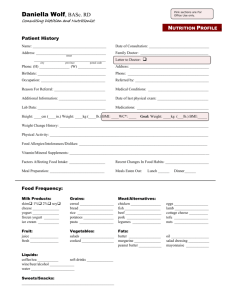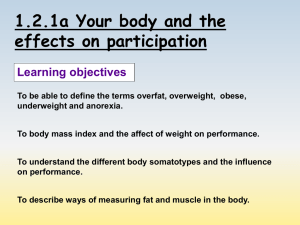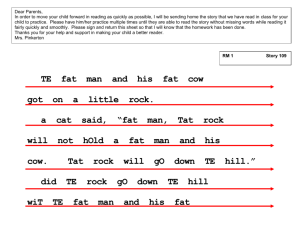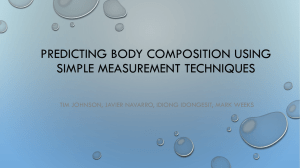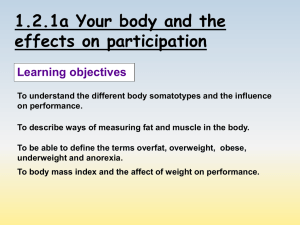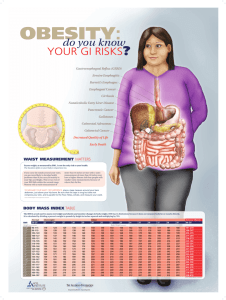128 - The AIDS InfoNet
advertisement
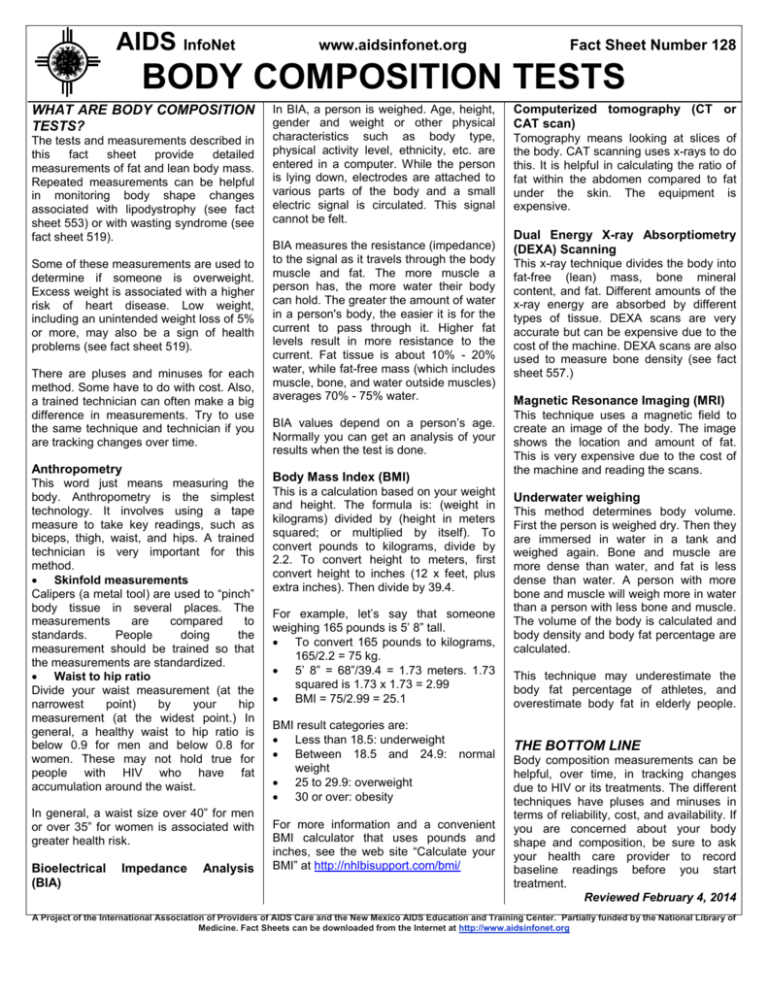
AIDS InfoNet www.aidsinfonet.org Fact Sheet Number 128 BODY COMPOSITION TESTS WHAT ARE BODY COMPOSITION TESTS? The tests and measurements described in this fact sheet provide detailed measurements of fat and lean body mass. Repeated measurements can be helpful in monitoring body shape changes associated with lipodystrophy (see fact sheet 553) or with wasting syndrome (see fact sheet 519). Some of these measurements are used to determine if someone is overweight. Excess weight is associated with a higher risk of heart disease. Low weight, including an unintended weight loss of 5% or more, may also be a sign of health problems (see fact sheet 519). There are pluses and minuses for each method. Some have to do with cost. Also, a trained technician can often make a big difference in measurements. Try to use the same technique and technician if you are tracking changes over time. Anthropometry This word just means measuring the body. Anthropometry is the simplest technology. It involves using a tape measure to take key readings, such as biceps, thigh, waist, and hips. A trained technician is very important for this method. Skinfold measurements Calipers (a metal tool) are used to “pinch” body tissue in several places. The measurements are compared to standards. People doing the measurement should be trained so that the measurements are standardized. Waist to hip ratio Divide your waist measurement (at the narrowest point) by your hip measurement (at the widest point.) In general, a healthy waist to hip ratio is below 0.9 for men and below 0.8 for women. These may not hold true for people with HIV who have fat accumulation around the waist. In general, a waist size over 40” for men or over 35” for women is associated with greater health risk. Bioelectrical (BIA) Impedance Analysis In BIA, a person is weighed. Age, height, gender and weight or other physical characteristics such as body type, physical activity level, ethnicity, etc. are entered in a computer. While the person is lying down, electrodes are attached to various parts of the body and a small electric signal is circulated. This signal cannot be felt. BIA measures the resistance (impedance) to the signal as it travels through the body muscle and fat. The more muscle a person has, the more water their body can hold. The greater the amount of water in a person's body, the easier it is for the current to pass through it. Higher fat levels result in more resistance to the current. Fat tissue is about 10% - 20% water, while fat-free mass (which includes muscle, bone, and water outside muscles) averages 70% - 75% water. BIA values depend on a person’s age. Normally you can get an analysis of your results when the test is done. Body Mass Index (BMI) This is a calculation based on your weight and height. The formula is: (weight in kilograms) divided by (height in meters squared; or multiplied by itself). To convert pounds to kilograms, divide by 2.2. To convert height to meters, first convert height to inches (12 x feet, plus extra inches). Then divide by 39.4. For example, let’s say that someone weighing 165 pounds is 5’ 8” tall. To convert 165 pounds to kilograms, 165/2.2 = 75 kg. 5’ 8” = 68”/39.4 = 1.73 meters. 1.73 squared is 1.73 x 1.73 = 2.99 BMI = 75/2.99 = 25.1 BMI result categories are: Less than 18.5: underweight Between 18.5 and 24.9: weight 25 to 29.9: overweight 30 or over: obesity normal For more information and a convenient BMI calculator that uses pounds and inches, see the web site “Calculate your BMI” at http://nhlbisupport.com/bmi/ Computerized tomography (CT or CAT scan) Tomography means looking at slices of the body. CAT scanning uses x-rays to do this. It is helpful in calculating the ratio of fat within the abdomen compared to fat under the skin. The equipment is expensive. Dual Energy X-ray Absorptiometry (DEXA) Scanning This x-ray technique divides the body into fat-free (lean) mass, bone mineral content, and fat. Different amounts of the x-ray energy are absorbed by different types of tissue. DEXA scans are very accurate but can be expensive due to the cost of the machine. DEXA scans are also used to measure bone density (see fact sheet 557.) Magnetic Resonance Imaging (MRI) This technique uses a magnetic field to create an image of the body. The image shows the location and amount of fat. This is very expensive due to the cost of the machine and reading the scans. Underwater weighing This method determines body volume. First the person is weighed dry. Then they are immersed in water in a tank and weighed again. Bone and muscle are more dense than water, and fat is less dense than water. A person with more bone and muscle will weigh more in water than a person with less bone and muscle. The volume of the body is calculated and body density and body fat percentage are calculated. This technique may underestimate the body fat percentage of athletes, and overestimate body fat in elderly people. THE BOTTOM LINE Body composition measurements can be helpful, over time, in tracking changes due to HIV or its treatments. The different techniques have pluses and minuses in terms of reliability, cost, and availability. If you are concerned about your body shape and composition, be sure to ask your health care provider to record baseline readings before you start treatment. Reviewed February 4, 2014 A Project of the International Association of Providers of AIDS Care and the New Mexico AIDS Education and Training Center. Partially funded by the National Library of Medicine. Fact Sheets can be downloaded from the Internet at http://www.aidsinfonet.org


